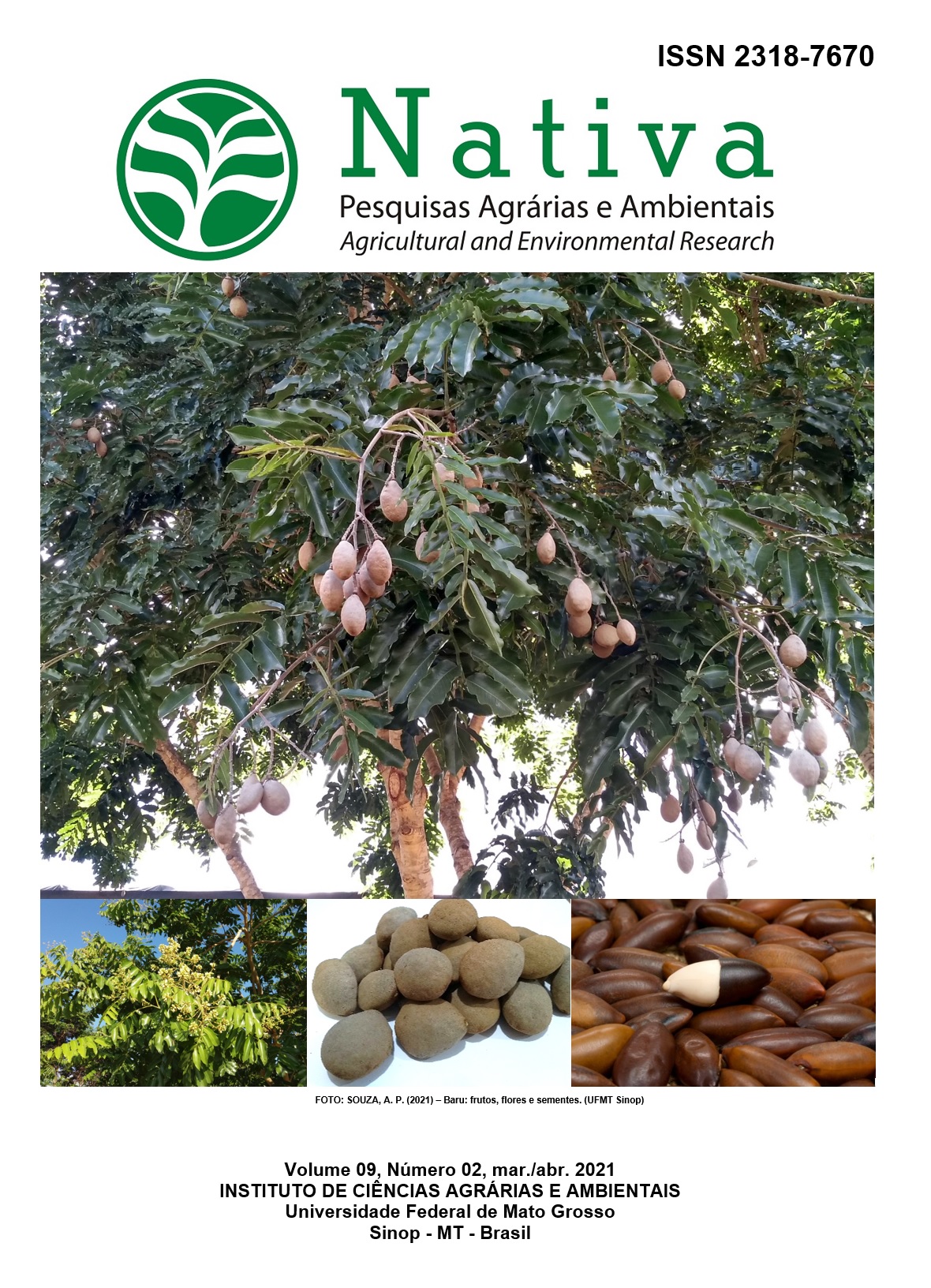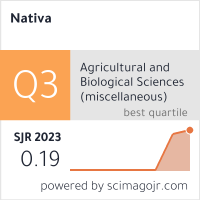USE OF ACTIVATED CHARCOAL AS BIO-ADSORBENT FOR TREAMENT OF RESIDUAL WATERS: A REVIEW
DOI:
https://doi.org/10.31413/nativa.v9i2.11387Palavras-chave:
Efluentes industriais, Contaminantes, Gestão ambientalResumo
ABSTRACT: Adsorption is gaining attention by becoming one of the most used technologies for the removal of contaminants from water. Adsorption with activated charcoal (AC) is an efficient method for treatment of effluents; the main advantage of AC production is the use of residues that would be inappropriate discarded. The objective of this work was to gather and organize the information available about the potential of using activated charcoal as a bio-adsorbent. Researches were conducted on scientific articles about the production of activated charcoal with adsorption characteristics for the removal of contaminants from residual waters. The efficiency of this technique is dependent on different parameters that affect the adsorption process, such as: pH of the solution, dye initial concentration, contact time, adsorbent amount, and temperature. The articles studied showed that the bio-adsorbent characteristics of charcoals are promising for the removal of pollutants from residual waters. The isotherm adsorption models developed by Langmuir, Freundlich, and Brunauer, Emmett, and Teller (BET) are often used to evaluate the adsorption capacity of activated charcoals.
Keywords: industrial effluents; contaminants; environmental management.
Emprego do carvão ativado como bioadsorvente para o tratamento de águas residuais: uma revisão
RESUMO: A adsorção vem ganhando destaque com uma das tecnologias mais empregadas na remoção de contaminantes em águas. No tratamento de efluentes, a adsorção com carvão ativado (CA) apresenta-se como um método eficiente. A principal vantagem da produção de CA é o aproveitamento de resíduos que seriam descartados de forma inadequada. O objetivo desta pesquisa é organizar algumas informações disponíveis com relação ao potencial do carvão ativado como bioadsorvente. Foram realizadas pesquisas em periódicos sobre produção de carvão ativado com características adsortivas na remoção de contaminantes em águas residuais. A eficácia dessa técnica sob diferentes parâmetros influencia no processo de adsorção, tais como: pH da solução, concentração inicial do corante, tempo de contato, quantidade do adsorvente e temperatura. Em todos os artigos estudados, as características dos carvões como bioadsorventes se mostraram promissores no processo para remoção de poluentes em águas residuais. Conclui-se que os modelos de isotermas de adsorção desenvolvidos por Langmuir, Freundlich e BET são frequentemente utilizados para avaliar a capacidade de adsorção dos carvões ativados.
Palavras-chave: efluentes industriais; contaminantes; gestão ambiental.
Referências
ABDEL-GHANI, N. T.; EL-CHAGHABY, G. A.; RAWASH, E. A.; LIMA, E. C. Adsorption of coomassie brilliant blue r-250 dye onto novel activated carbon prepared from Nigella sativa L. Waste: Equilibrium, kinetics and thermodynamics running title: adsorption of brilliant blue dye onto Nigella sativa L. Waste activated carbon. Journal of the Chilean Chemical Society, Concepción, v. 62, n. 2, p. 3505- 3511, 2017. DOI: 10.4067/S0717-97072017000200016
AMIN, N. K. Removal of reactive dye from aqueous solutions by adsorption onto activated carbon prepared from sugarcane bagasse pith. Desalination, Amsterdam, v. 223, n. 1-3, p. 152-161, 2008. DOI: 10.1016/j.desal.2007.01.203
ISLAM, M. D. A.; AHMED, M. J.; KHANDAY, W. A.; ASIF, M.; HAMMEED, B. H. Mesoporous activated carbon prepared from NaOH activation of rattan (Lacosperma secundiflorum) hydrochar for methylene blue removal. Ecotoxicology and Environmental Safety, New York, v. 138, n. 1, p. 279-285, 2017. DOI: 10.1016/j.ecoenv.2017.01.010
BANDOSZ, T. J. Activated carbon surfaces in environmental remediation. New York: Elsevier, 2006. 571 p.
BAZRAFSHAN, E.; AMRIAN, P.; MAHVI, A. H.; ANSARI-MOGHADDAM, A. Application of adsorption process for phenolic compounds removal from aqueous environments: a systematic review. Global NEST Journal, Lesbos, v. 18, n. 1, p. 146-163, 2016. DOI: 10.30955/gnj.001709
BORGES, W. M. S.; CASTRO, G. M. M.; BIANCHI, M. L.; NOBRE, J. R. C.; RESENDE, E. C.; CASTRO, J. P.; GUERREIRO, M. C. Produção, caracterização e avaliação da capacidade adsortiva de carvões ativado em forma de briquete. Matéria, Rio de Janeiro, v. 21, n. 4, p. 930-942, 2016. DOI: 10.1590/s1517-707620160004.0086
BOUCHELTA, C.; MEDJRAM, M. S.; BERTRAND, O.; BELLAT, J. P. Preparation and characterization of active carbon from date stones by physical activation with steam. Journal of Analytical and Applied Pyrolysis, Amsterdam, v. 82, n. 1, p. 70-77, 2008. DOI: 10.1016/j.jaap.2007.12.009
DABROWSKI, A.; PODKOSCIELNY, P.; HUBICKI, Z.; BARCZARK, M. Adsorption of phenolic compounds by activated carbon-a critical review. Chemosphere, Oxford, v. 58, n. 8, p. 1049-1070, 2005. DOI: 10.1016/j.chemosphere.2004.09.067
DI BERNARDO, L.; DANTAS, A. D. B. Métodos e técnicas de tratamento de água. 2 Ed. São Carlos: Rima, 2005. 1565 p.
DIZBAY-ONAT, M.; VAIDYA, U. K.; LUNGUC, C. T. Preparation of industrial sisal fiber waste derived activated carbon by chemical activation and effects of carbonization parameters on surface characteristics. Industrial Crops and Products, Parlier, v. 95, n. 1, p. 583-590, 2017. DOI: 10.1016/j.indcrop.2016.11.016
GIMENEZ, I. F.; FERREIRA, O. P.; ALVES, O. L. Desenvolvimento de ecomateriais: materiais porosos para aplicação em Green Chemistry. Campinas: UNICAMP, 2014. 17 p.
GORGULHO, H. F.; MESQUITA, J. P.; GONÇALVES, F.; PEREIRA, M. F. R.; FIGUEIREDO, J. L. Characterization of the surface chemistry of carbon materials by potentiometric titrations and temperature-programmed desorption. Carbon, Oxford, v. 46, n. 12, p. 1544-1555, 2008. DOI: 10.1016/j.carbon.2008.06.045
HAO, W.; BJÖRNERBÄCK, F.; TRUSKINA, Y.; BENGOECHEA, M. O.; SALAZAR-ALVAREZ, G.; BARTH, T.; HEDIN, N. High-performance magnetic activated carbon from solid waste from lignin conversion processes. 1. Their use as adsorbents for CO2. ACS Sustainable Chemical Engineering, Austin, v. 5, n. 4, p. 3087-3095, 2017. DOI: 10.1021/acssuschemeng.6b02795
JUNG, K. W.; CHOI, B. H.; HWANG, M.; JEONG, T.; AHN, K. Fabrication of granular activated carbons derived from spent coffee grounds by entrapment in calcium alginate beads for adsorption of acid orange 7 and methylene blue. Bioresource Technology, Essex, v. 219, n. 17, p. 185-195, 2016. DOI: 10.1016/j.biortech.2016.07.098
KUMAR, K. V.; SIVANESAN, S. Pseudo second order kinetics and pseudo isotherms for malachite green onto activated carbon: Comparison of linear and non-linear regression methods. Journal of Hazardous Materials, Amsterdam, v. 136, n. 3, p. 721-726, 2006. DOI: 10.1016/j.jhazmat.2006.01.003
LEITE, N. S.; SILVA, R. R.; MARQUES, J. J.; TAMBOURGI, E. B.; SILVA, G. F.; SILVA, M. S. Hydrocarbon removal from aqueous wastewater using activated carbon from Casuarina equisetifolia cones. Scientia Plena, Aracaju, v. 13, n. 07, p. 1-12, 2017. DOI: 10.14808/sci.plena.2017.074201
LOPES, N. P.; QUEIROZ, M. E. L. R.; NEVES, A. A. Influência da matéria orgânica na adsorção do fungicida Triadimenol pelo solo. Química Nova, São Paulo, v. 25, n. 4, p. 544-547, 2002. DOI: 10.1590/S0100-40422002000400006
MOHAN, D.; PITTMAN JR, C. Activated carbons and low cost adsorbents for remediation of tri and hexavalent chromium from water. Journal of Hazardous Materials, Amsterdam, v. 137, n. 2, p.762-811, 2006. DOI: 10.1016/j.jhazmat.2006.06.060
MORALI, U.; DEMIRAL, H.; ŞENSÖZ, S. Optimization of activated carbon production from sunflower seed extracted meal: Taguchi design of experiment approach and analysis of variance. Journal of Cleaner Production, Amsterdam, v. 186, p. 1-44, 2018. DOI: 10.1016/j.jclepro.2018.04.084
NAEEM, M. S.; JAVED, S.; BAHETI, V.; WIENER, J.; JAVED, M. U.; HASSAN, S. Z. U.; MAZARI, A.; NAEEN, J. Adsorption kinetics of acid red on activated carbon web prepared from acrylic fibrous waste. Fibers and Polymers, Seoul, v. 19, n. 1, p. 71-81, 2018. DOI: 10.1007/s12221-018-7189-5
NOWROUZI, M.; BEHIN, J.; YOUNESI, H.; BAHRAMIFAR, N.; CHARPENTIER, P.A.; ROHANI, S. An enhanced counter-current approach towards activated carbon from waste tissue with zero liquid discharge. Chemical Engineering Journal, Lausanne, v. 326, n. 15, p. 934-944, 2017. DOI: 10.1016/j.cej.2017.05.141
PEREIRA, E. I. Production of activated carbon from different precursors using FeCl3 as an activator agent. 2010. 72 f. Dissertation (Master in Agrochemistry) – Universidade Federal de Lavras, Lavras.
POBLETE, R.; OLLER, I.; MALDONADO, M. I.; LUNA, Y.; CORTES, E. Cost estimation of COD and color removal from landfill leachate using combined coffee-waste based activated carbon with advanced oxidation processes. Journal of Environmental Chemical Engineering, Amsterdam, v. 5, n. 1, p. 114-121, 2017. DOI: 10.1016/j.jece.2016.11.023
SELVARAJU, G.; ABUBAKAR, N. K. Production of a new industrially viable green-activated carbon from Artocarpus integer fruit processing waste and evaluation of its chemical, morphological and adsorption properties. Journal of Cleaner Production, Amsterdam, v. 141, n. 10, p. 989-999, 2017. DOI: 10.1016/j.jclepro.2016.09.056
SOUZA, L. A. Filtração por carvão ativado. Disponível em: https://mundoeducacao.bol.uol.com.br/quimica/filtracao-por-carvao-ativado.htm. Acesso em: 28 de nov, 2018.
UTRILLA, J. R.; SÁNCHEZ-POLO, M.; GÓMEZ-SERRANO, V.; ÁLVAREZ, P. M.; ALVIM-FERRAZ, M. C. M.; DIAS, M. Activated carbon modifications to enhance its water treatment applications. Journal of Hazardous Materials, Amsterdam, v. 187, n. 1-3, p. 1-23, 2011. DOI: 10.1016/j.jhazmat.2011.01.033
VALENÇA, R. M.; MACÊDO, W. V.; RODRIGUES, C. C.; NÓBREGA, S. W. Adsorção de fluoreto em solução aquosa e em água de abastecimento em carvão ativado à base de casca de castanha-do-Brasil. Engenharia Ambiental, Espírito Santo do Pinhal, v. 14, n. 2, p. 44-54, 2017.
WANG, J.; WANG, J.; WU, F.; QIU, N.; LIANG, Y.; FANG, S.; JIANG, X. Preparation of activated carbon from a renewable agricultural residue of pruning mulberry shoot, African. Journal of Biotechnology, Amsterdam, v. 9, n. 19, p. 2762-2767, 2010.
WAWRZKIEWICZ, M.; WISNIEWSKA, M.; GUN’KO, V. G.; ZARKO, V. I. Adsorptive removal of acid, reactive and direct dyes from aqueous solutions and wastewater using mixed silica–alumina oxide. Powder Technology, Lausanne, v. 278, n. 6, p. 306-315, 2015. DOI: 10.1016/j.powtec.2015.03.035
ZAREI, A.; BAZRAFSHAN, E.; FARIDI, H.; KHAKSEFIDI, R.; ALIZADEH, M. The evaluation of removal efficiency of phenol from aqueous solutions using Moringa peregrina tree shell ash. Iranian Journal of Health Sciences, Teerã, v. 1, n. 1, p. 65-74, 2013. DOI: 10.18869/acadpub.jhs.1.1.65
ZDRAVKOV, B. D.; CERMÁK, J. J.; SEFARA, M.; JANKU, J. Pore classification in the characterization of porous materials: a perspective. Central European Journal of Chemistry, Warsaw, v. 5, n. 2, p. 385-395, 2007. DOI: 10.2478/s11532-007-0017-9
Downloads
Publicado
Versões
- 2023-10-02 (2)
- 2021-06-06 (1)
Edição
Seção
Como Citar
Licença
Copyright (c) 2021 Nativa

Este trabalho está licenciado sob uma licença Creative Commons Attribution-NonCommercial 4.0 International License.
Direitos Autorais para artigos publicados nesta revista são do autor, com direitos de primeira publicação para a revista. Em virtude de a aparecerem nesta revista de acesso público, os artigos são de uso gratuito, com atribuições próprias, em aplicações educacionais e não-comerciais.
A artigos publicados nessa revista, podem ser reproduzidos parcialmente ou utilizados como referência por outros autores, desde que seja cita a fonte, ou seja, a Revista Nativa.
Copyright for articles published in this journal are the authors, with first publication rights granted to the journal. The journal shows open access, and articles are free to use, with proper attribution, in educational and non-commercial.
The articles published in this journal may be reproduced in part or used as a reference by other authors, provided that the source is quoted.






